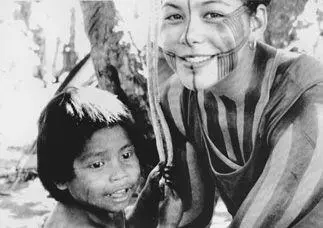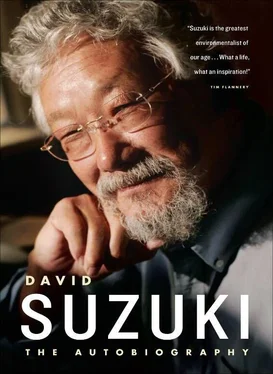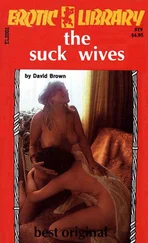We arrived in Rio and settled into an apartment on the Condado, just north of Ipanema. The night before the summit, Tara went out for groceries, only to see Paiakan's face on the cover of a national magazine with the words “O Savagem”—“the Savage!”—printed across his image. Paiakan was accused of picking up seventeen-year-old Letiçia Ferreira in a car on the way to a picnic near Redenção and of attacking and raping her with Irekran's assistance and in the presence of their children. The sensational charges, described as “facts” in the most lurid language in the Brazilian news magazine, were announced by the young woman's uncle, the mayor of Redenção, who had campaigned on a virulent anti-Indian platform. Paiakan and his family had retreated to the safety of Aucre.
The whole thing stank to high heaven, but as a tactic to keep Paiakan out of the limelight, it worked brilliantly. At meetings of non-government organizations (NGO) at the Hotel Gloria during the summit, Paul Watson and I shook our heads as one by one the spokespeople for environmental organizations distanced themselves from Paiakan.
In 1994, Paiakan was acquitted in absentia for lack of evidence. But years later, the charges were reinstated. I have pressed Brazilian lawyer Frank Melli, who is a staunch supporter of Paiakan's, to see whether Paiakan can be granted a pardon now that more than thirteen years have passed. He has been silenced far more effectively than if, like Chico Mendes, he had been martyred by assassination. In the meantime, we have set up a trust that will enable Paiakan's children, as is his wish, to go on to university so that they can be educated and work for their people if that is their goal.
When we had visited Paiakan in 1989, he mused that in Canada we pay our scholars and experts to teach at universities and pass on their knowledge to young people. “Our elders are our professors,” he said, and told me he would like to have a Kaiapo university where elders could teach young people how to live in the forest. He wanted to show the forest could be valuable left standing. He wanted, for example, to establish a research station in a pristine area to which scientists would pay to come from the outside world; they would hire Kaiapo cooks and assistants, and they would both teach and learn from the Kaiapo.
Tara and I thought it was a great idea, and with the help of Barbara Zimmerman, the Toronto-born herpetologist who had worked in the Amazon for years and invited us to the Manaus research station, we began to set it up. To pay for it, we organized small, exclusive tours to Aucre and its fledgling station fifteen miles upriver, starting in 1990. People could experience a traditional Indian community and a tropical rain forest. Barb is a remarkable woman and scientist, the only person we could imagine who could pull off this research station project in so remote a place. She handled the Brazilian end of the visits, and Tara looked after the complex arrangements at home.

Severn with Iremaõ, Paiakan's son, at the Pinkaiti research station
Using the money brought in by these tours, the first scientific research station in the eastern lower half of the Amazon watershed was successfully established. After the David Suzuki Foundation was born, we transferred the project to the foundation. But it was a huge drain on Tara's time and energy, and when Conservation International, a well-funded American environmental organization that works to protect wilderness, offered to take charge of the project, we were happy to hand it over.
IN 2001, SEVERN RECEIVED a research grant from Yale University, where she was a junior, to study a species of tree in the Amazon rain forest in that same research station her mom and I had helped get going, now called Projeto Pinkaiti. With the funding of Conservation International and under the supervision of Barbara Zimmerman, the station was flourishing, with a steady stream of scientists and students from Europe and North America.
After hearing Sev's stories about being back in the Amazon, I decided to return to Aucre to see Paiakan while we were in Brazil filming for The Sacred Balance . Paiakan was heavier, and the village too had changed since my last visit. For some unfathomable reason, the thatched roofs had been replaced with metal. A dispensary with a concrete floor had appeared, staffed by a Brazilian who gave out medical drugs; a solar-charged television set was turned on for a few hours a night to show soccer while I was there, and a hut had been built for people who were coming and going to the research station upriver. In Aucre, I woke to the tap, tap, tap of metal devices being used to shell Brazil nuts for the Body Shop chain, which uses the extracted oil in its cosmetics. The plane we had delivered in 1989 still linked the Kaiapo villages together.
The cook for the camp at Aucre was a Brazilian who had a genuine affection for the Kaiapo and had been adopted by them as a Kaiapo, which is a tremendous honor and act of trust. To be adopted, he had to fast for a day, have his hair shaved off, and undergo an entire day of ritual dancing and painting.
Another big change was that Paiakan's daughters were being educated away from the village, in Redenção. Paiakan allowed mahogany trees to be selectively logged for the money he needed to keep the girls in town, and Juneia Mallus is disillusioned by this, but Barb Zimmerman believes such selective logging has a relatively small ecological impact. Paiakan still hopes to rally more outside supporters for preservation of the Amazon, but time has gone by and he has been stuck in the village, marginalized, forgotten by the media.
While I was there, Paiakan and I went fishing again. Unlike our summer visit of 1989, this one took place right after the rainy season and the river was quite high, flowing over the banks and into the forest. As we started off, Paiakan drove the boat right into a bush overhanging the river and began picking the walnut-sized orange fruit and dropping them into the bottom of the craft. When he had accumulated quite a large pile, he backed the boat away and, as we began our trip downriver, he told me to bait up with the fruit. If I hadn't known any better, I would have thought he was playing a trick on this gringo, and I was a little skeptical, but I dutifully pushed a hook through the skin of the fruit.
“Cast it out,” he urged me, so I began to cast in a half-hearted way. I just couldn't imagine fishing with a fruit on my hook. What if someone saw me? Paiakan killed the engine, baited a hand line with another fruit, and began to throw it toward the trees along the river's edge. Right away he was hauling in a huge, flat, silvery fish. Well, I began to cast in earnest then and immediately hooked a fish, which broke my line. Paiakan caught three fish, while I hooked several and lost them all. We drifted down to a place where there were large rocks and pools; Paiakan jumped out and cast a hand net, pulling in several of the same species at each throw. In the end, we had ten beautiful fish, and once again I was awed by Paiakan's skill and knowledge. I caught no fish that day.
All too soon, my short visit was over, and I began to prepare to leave. Irekran offered to paint my body, which I had always hoped for, but I knew I would have to be filming again in a few days. “Not my face,” I told her, with mixed feelings. Severn had been painted and I would love to have had that experience, but it would also have made me stand out and be subjected to stares in airports, which did not please me. So Irekran painted me up to my chin, with long, vertical stripes of dark-black dye. When I asked her how long the paint would last, she answered, “About ten days.” Wrong. It lasted a month and created a buzz when I went to the gym back in Canada.
Читать дальше



![David Jagusson - Devot & Anal [Hardcore BDSM]](/books/485905/david-jagusson-devot-anal-hardcore-bdsm-thumb.webp)









